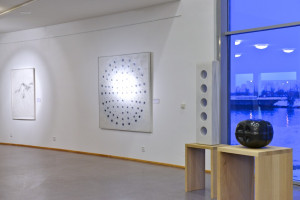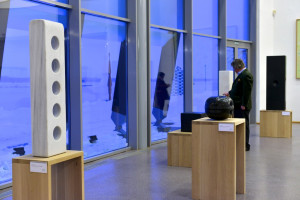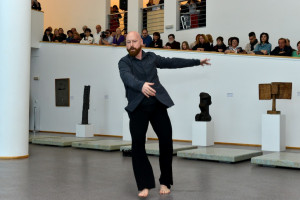
Sculptures Should Take Root
The Austrian sculptor Karl Prantl regarded stone as part of nature. Accordingly, stone sculptures should become an inseparable part of nature because they are nature by themselves. This creed permeates the artist’s entire work and is reflected in its character and his artistic activities. Prantl had an intimate knowledge of stone, of its shapes, properties and textures, and literally lived with it. This enabled him to penetrate into its inner life, to reveal its magic and meditation powers. Rather he perceived it as a complex matter with its “own life”. He respected and exploited the properties of stone in his creative process. Prantl did not use stone as a medium to depict the outer world, but revealed the world of its own.
He explored all his conceptions and possibilities for carving stone, drawing on and seemingly adapting to them. This enabled him to define his conceptions and objectives. “While carving stone, you discover the spirit of this material and its exceptional properties“ (Brancusi). Karl Prantl continued discovering the power of meditation in stone. He strove to achieve the connection between materiality and spirituality reminiscent of archaic cult rites at which rituals in animism were performed. Cult stones, stelae, columns and portals as sites for the concentration of spiritual powers had appeared before the creation of deities. Stone transferred its powers throughout history and gave its energy to those who wanted to and were able to reveal it. In the past there were strong individuals or periods ranging from Egyptian sphinxes to Brancusi.
Meditation stones as part of open countryside reveal a parallel aspect of Prantl’s philosophical nature and his way of thinking transformed into the idea of the sculpture symposium. Through stones he aimed at the freedom of thinking, at relaxing binding regulations, pressures, limitations and prohibitions so typical of the divided world of that time. He formed a new conception of sculpture in the natural environment. Founded in the old Roman quarry at Sankt Margarethen in 1959, the “Symposium of European Sculptors” followed the idea of joining sculptors from different countries on the basis of the freedom of creation and thinking, regardless of cultural, conceptual or other differences. This idea spread widely and symposia have been held all over the world since then.
The artists from behind the Iron Curtain had a unique opportunity to create and present their artworks within the European context. This signalled the beginning of Prantl’s close friendships with Czech and Slovak artists in particular. Thanks to his participation in the sculpture symposium at Vyšné Ružbachy held in 1965, the site takes prides in an outstanding stone sculpture, entitled Calling.
The first meditation sculptures had already been made in 1956 when he created the basic form of one type of sculptures: the cuboid with a cylindrical penetration in the middle. Prantl rigorously worked with basic archetypal forms – the cuboid, the prism, and the sphere – largely composing them in vertical or horizontal lines. Preserving the block-like shape of stone, Prantl’s treatment of space has a specific form. Based on communication between the sculpture and its surroundings, it is more meditative than physical. Physical spatial penetrations occur in stones with cylindrical perforations in which space is defined against material. For Prantl the relationship between material and space is a priority, especially open countryside where materiality has its natural place. It results from a very sophisticated communication with space, mostly only with a minimum treatment and surface segmentation. The majority of stones have smooth surface without traces of tools, and are rippled and polished until they are smooth. It seems that the artist only lightly touched them with hands, caressing the surface. Sometimes, he segmented the broken stone surface by globular depressions and convexities, placing them either regularly, rhythmically, or in irregular clusters. He often left traces after working a rougher surface, thus emphasising the natural origin of the material. A differently worked surface of stone tends to open various possibilities of the reflection and vibration of light. Reflections of light, the communication of light with the surface of stone, create a distinctive visual perception, which forms a complex of meditation effects of sculptures.
The motifs of many of his “meditation stones” were inspired by religious symbolism – the rosary, the crucifix, the altar, and the Stations of the Cross. These specifically treated motifs alternate and seem to be directed beyond the theme; they become the sign trace, which loses its original connotation, and it depends on the perceiver how he/she perceives them.
The central part of the exhibition consists of a set of fourteen slabs of Amazon stone, the Stations of the Cross as a symbol of human suffering. Prantl created several opuses on this subject, the most famous being Nuremberg in which he composed stones worked by the prisoners of concentration camps. Thus he shifted the religious theme to profane contexts. The work is unique from several aspects: it is designed to touch feet, to involve spiritual and physical perception as a complex experience. While the former is publicly available in churches and in the public realm, this series is sited in the countryside near the artist’s studio in Pöttsching and has its world premiere at the Danubiana. The exhibition is complemented by a selection of interior “meditation stones” and delicate linear drawings.
The painter Uta Peyrer-Prantl (1939) is concerned with painting as an abstract phenomenon. She analytically penetrates into the essence of colour, re-evaluating the pointillist method. The artist chose the principle of blurred enlargements of points and circles, which tend to circulate centripetally and centrifugally, and the subsequent analysis of colour is associated with the space-time vector. Her magical pictures guide the perceiver to astral connections beyond one’s experience.
Katarina Prantl (1958) studied with Professors M. Weiler and A. Rainer at the Academy of Fine Arts in Vienna. The conception of her work resonates with gestural and expressive painting. It is characterised by a clear-cut sense of work with tone in tone, especially graded red and green and the synthesis of brushwork with the surface and linear gesture. Her canvases give the impression of poetry in pictures.
The family of Karl Prantl took the initiative and invited to the exhibition the artist’s closest friends: Václav Boštík, Tibor Huszár, Miloslav Chlupáč, Alojz Klimo, Tamara Klimová, Eva Kmentová, Viera Kraicová, Zdeněk Palcr, Andrej Rudavský, Jaroslav Seifert, Barna von Sartory, Zbyněk Sekal, Adriena Šimotová, Michal Uher, Rudolf Uher and Olbram Zoubek.
At the opening of the exhibition, Sebastian Prantl, the artist’s son, gave a dance performance and invited spectators to join him. Sebastian Prantl is a choreographer, dancer and artistic director of the Dance Studio in Vienna, founded in 1988.
Eva Trojanová







